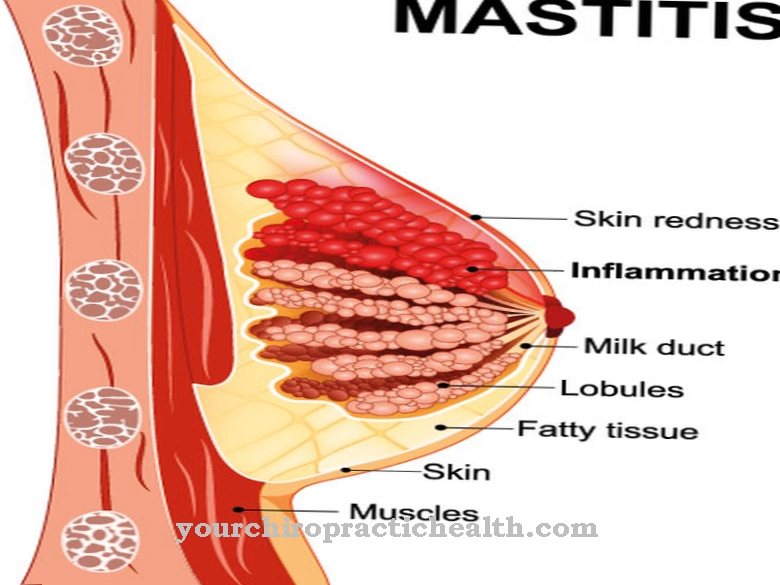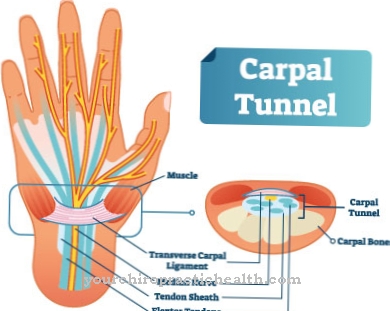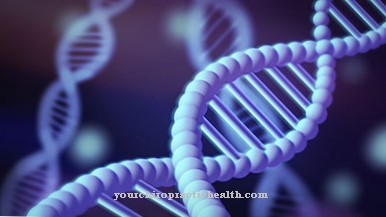The medic speaks when he speaks of one adenoid-cystic carcinoma starts from a malignant tumor. Although the tumor occurs relatively rarely, it is fatal in many cases. Mainly because the adenoid-cystic carcinoma spreads, so that other organs can also be attacked by the cancer cells. The 5-year survival rate is 89 percent; the 15-year survival rate is only 40 percent.
What is adenoid cystic carcinoma?

Adenoid-cystic carcinoma is a malignant tumor. However, the tumor rarely occurs. The adenoid-cystic carcinoma is derived from the glandular tissues; Adenoid-cystic carcinoma of the head or neck area is mainly diagnosed.
The salivary glands are among the most common places of manifestation; adenoid-cystic carcinoma occurs mainly in the parotid, mandibular or even in the small salivary glands. Sometimes doctors have been able to identify further localizations over and over again in recent years.
These include adenoid-cystic carcinoma in the lacrimal glands, the nose and paranasal sinuses, the windpipe, in the larynx, the lungs, the skin, in the bronchi, the mammary gland, in the cervix, in the external auditory canal, in the prostate or in the bartholin -Gland could form. It is characterized by the slow growth of the adenoid-cystic carcinoma at the beginning.
However, the tumor shows a pronounced tendency to infiltrate, which primarily affects the surrounding tissue. For this reason, the adenoid-cystic carcinoma can only rarely be completely removed, so that new tumor formations can occur again and again.
The tumor has been described by Robin and Laboulbene; It was not until 1856 that the tumor was documented in more detail by Theodor Billroth, a surgeon. Because of this, adenoid cystic carcinoma is still used today Cylindrom called because the tumor cells have a cylindrical shape. The term adenoid cystic carcinoma was first used by James Ewing, a pathologist.
causes
So far, there are no known causes why adenoid-cystic carcinoma develops at all. There is also no knowledge of environmental or genetic risk factors that sometimes promote the formation of adenoid-cystic carcinoma. However, at the molecular genetic level, doctors have been able to determine that the so-called p53 tumor suppressor gene has been inactivated, especially in aggressive and advanced adenoid-cystic carcinomas.
New studies also refer to a deletion of certain chromosomal regions (such as the region 1p32-36). The most common genetic abnormalities observed in connection with adenoid-cystic carcinoma have so far been found in this region.
Symptoms, ailments & signs
Those affected mainly complain of symptoms of paralysis that can appear all over the face. Swelling of the cervical lymph nodes also occurs. Sometimes diffuse pain or paresthesia can occur.
Due to the fact that this is a very rare tumor, adenoid-cystic carcinoma is often diagnosed very late. The advantage is that the tumor grows slowly, but at the same time there is a disadvantage: Even if the tumor is growing slowly, it can still spread, so that other organs are sometimes already infected by cancer cells.
Diagnosis & course
The doctor can only make a definitive diagnosis after the tumor tissue has been removed (fine needle puncture, biopsy) and then a microscopic examination has been carried out by pathologists. In the field of propagation diagnostics, imaging methods such as magnetic resonance tomography, computed tomography or positron emission tomography are mainly used.
On histology, adenoid-cystic carcinoma shows a highly differentiated picture; the tumor is best known for its very infiltrative growth behavior. The growth pattern is glandular or sieve-like. Adenoid-cystic carcinoma grows slowly, but permanently, so that the 5-year survival rate of 89 percent is favorable, but the 10-year survival rate is just 65 percent.
The 15-year survival rate is just 40 percent. For the course of the disease, the histological growth pattern, the tumor size, the localization and also the clinical stage, the question of whether there is bone involvement and also the status of the surgically placed resection margins are of major importance.
If there is a cribriform or tubular growth pattern, the disease may progress well; Lymph node involvement is possible, but only rarely (5 to 25 percent). Fine metastases that subsequently become lodged in the lungs, brain, bones or liver are possible. It is therefore a reality in 25 to 55 percent of all cases that other tumors develop. If the tumor cells spread, the survival rate - within the first five years - is just 20 percent.
Complications
Adenoid-cystic carcinoma is a rather rarely occurring malignant salivary gland tumor that manifests itself in the head and neck area. It grows slowly from the roof of the mouth along the blood vessels and nerves. The symptom becomes noticeable as a very painful swelling. In acute cases also by means of facial paralysis.
The affected person needs immediate medical help to reconcile the cause. As a further complication, the tumor can form lumps in the lymph nodes that spread to the brain, esophagus and lungs. If the affected person does not receive treatment for the symptom, the infection can also spread to the skin, prostate and cervix.
Women are more often affected by the symptom than men. The age structure of the patients is between the ages of 30 and 70 and rarely occurs in childhood. Due to the persistent recurrent nature of the adenocarcinoma, a complete cure is not possible. A detailed pathogenesis of whether the symptom is genetic or environmental is not yet known.
The adenoid-cystic carcinoma is extensively removed in a surgical procedure. The therapy depends on the diagnosis. Since the tumor cannot be removed completely due to the spread of the tumor, combined radiation therapy is recommended for containment. The form of therapy can strain the psyche and physical tolerance of the patient and requires intensive care.
When should you go to the doctor?
The typical warning signs of adenoid cystic carcinoma are paralysis of the face and swelling of the cervical lymph nodes. Sometimes there are also diffuse pain and abnormal sensations, which increase as the disease progresses. If one or more of these symptoms are noticed, it is advisable to see a doctor immediately. A quick medical evaluation can significantly improve the survival rate. It is therefore advisable to speak to the family doctor as soon as the first complaint occurs, for which there is no other explanation.
If a carcinoma is suspected, appropriate specialists should also be consulted. This is especially true if the person concerned has had cancer in the past. Genetic predispositions should also be considered and, if necessary, discussed with the doctor. Adenoid-cystic carcinoma must always be diagnosed by a doctor and then treated with the help of radiation therapy. Medical evaluation of the cancer should be carried out as early as possible in order to improve the chances of recovery and to rule out complications.
Doctors & therapists in your area
Treatment & Therapy
If the doctor makes the diagnosis that it is an adenoid-cystic carcinoma, he will initially prefer the complete removal of the tumor. The patient has to undergo a surgical procedure. The tumor is removed with a sufficient safety margin from the surrounding tissue.
To reduce the relapse rate, postoperative radiation therapies are ordered. Chemotherapy, however, is not recommended; So far there is no effective chemotherapy against adenoid-cystic carcinoma. So-called combination therapies, i.e. those consisting of chemotherapy and radiation therapy, are only used in a few cases - mainly for testing.
Outlook & forecast
The prognosis for adenoid-cystic carcinoma of the head or neck area is assessed differently when using radiation therapy. For one thing, it is said that the tumor does not jump on it. The value of a so-called neutron irradiation is judged increasingly positive.
Unfortunately, healing is often not possible. Complete removal of the tumor usually does not succeed because the tumor grows along nerves and blood vessels. New tumorous developments can therefore often be observed. Rapid tumor growth with daughter tumors is rarely documented.
Most adenoid-cystic carcinoma grows very slowly. However, this tumor tends to metastasize in the lungs and bones. The tendency to relapse is also relatively high. These factors make the prognosis appear in a bad light at first glance.
A five year survival rate is around 75%. The ten-year survival rate is still 30% and the twenty-year survival rate is still 10%. If daughter tumors appear in the lungs, the average survival time is three and a half years. It should be noted that in the late, rapidly infiltrating stage, mostly only palliative therapy seems to be possible. Especially when the metastasis has started.
prevention
Since there is currently no knowledge about the development of adenoid-cystic carcinoma, no preventive measures are known. It is important that - if the doctor makes the diagnosis of adenoid cystic carcinoma - immediate treatment is started.
Aftercare
In most cases, the options or measures for follow-up care for this disease are very limited. First and foremost, a quick and, above all, an early diagnosis is very important so that there is no further deterioration or other complaints and complications. As a result of this tumor, the life expectancy of the person affected is in most cases significantly reduced.
As a rule, further examinations are advisable even after successful treatment and removal of the tumor so that further tumors can be detected at an early stage. In most cases, the disease is treated by surgical removal of the tumor. After such a surgical procedure, the person concerned is dependent on bed rest.
Exertion or other stressful activities should be avoided in any case in order not to unnecessarily burden the body. In most cases, the patients are also dependent on the help and support of friends and acquaintances. This also applies to chemotherapy, for which most patients require extensive support from their relatives. This also includes psychological support for the person concerned.
You can do that yourself
Adenoid-cystic carcinoma is a malignant cancer that usually takes a severe course. The sick can support the treatment by changing their lifestyle. In addition to dietary and sporting measures, alternative healing methods are sometimes recommended.
Massages or acupuncture help relieve pain and are therefore an important part of therapy. The patients should discuss alternative treatment methods with the responsible doctor so that these can be optimally coordinated with the conservative therapy. In addition, general measures such as abstaining from alcohol and caffeine apply.
In order not to further irritate the esophagus, spicy, hot, cold and sour foods should be avoided as far as possible. A light diet is recommended, which can be supplemented with food supplements and appetite stimulants if the disease leads to malnutrition.
The sick should also talk to other sufferers. Talking to other cancer patients not only makes it easier to deal with the disease, but also often shows other ways to improve well-being and thereby improve quality of life in the long term. Finally, in the case of an adenoid-cystic carcinoma, the voice must be spared, as it is usually already badly affected by the tumor.








.jpg)



















